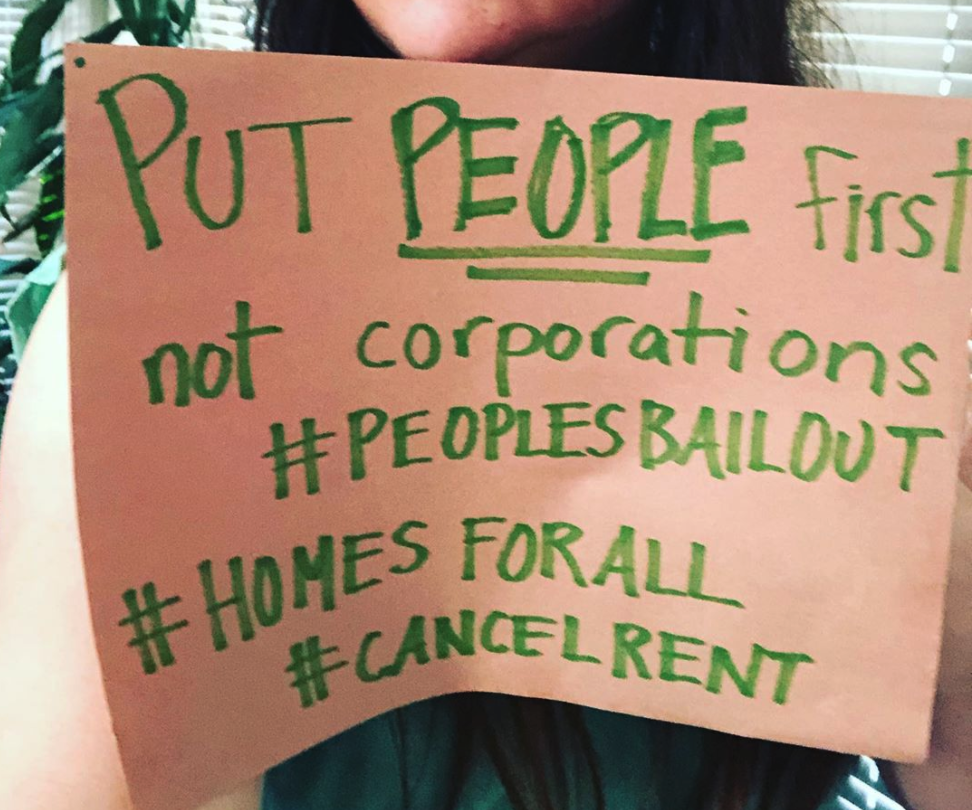- Health is the top priority, for all people, with no exceptions
- Economic relief must be provided directly to the people
- Rescue workers and communities, not corporate executives
- Make a down payment on a regenerative economy while preventing future crises
- Protect our democratic process while protecting each other
With this set of principles, the People’s Bailout hit the ‘virtual street’ on March 29 with a Digital Rally keynoted by Rev. William Barber and Stacy Abrams.
The live-streamed event (you can watch here) was emceed by Nelini Stamp of the Working Families Party who introduced an grassroots-activism-based line-up of speakers including the President of National Nurses United and organizers from Mijente, It Takes Roots, the National Domestic Workers Alliance and several other groups. Every speaker was a woman except for Rev. Barber.
The Rally offered a compelling framework to draw together the Resistance in the wake of COVID-19. Like the Peoples Bailout demands, the Rally spotlighted the extraordinary health crisis and the pandemic’s economic consequences and targeted the Trump administration’s irresponsible, racist and reactionary response.

The People’s Bailout was initiated by a dozen organizations with deep roots in the social justice movement. Less than a week after its website went up, 500 additional groups and eight members of Congress had endorsed the five principles. As of this writing close to half a million people have viewed the event and the 500 endorsing groups have grown to over 800.
It’s an auspicious beginning. And if this momentum can be maintained, the People’s Bailout could become a political umbrella for today’s battle to meet the urgent survival needs of millions while pointing to the longer-range task of transforming U.S. society.
Like the Women’s March in resistance, phase one
The massive Women’s March of the first full day of Donald Trump’s presidency set the initial political and moral tone for resistance to Trumpism in power. It spurred a wave of mass direct action that included, for example, the airport demonstrations against Trump’s Muslim Ban. It unleashed a flood of energy that poured into the electoral arena and in 2018 elected a squad of women-of-color progressives and flipped the House. The Women’s March “set a resistance pole” at a crucial moment when the landscape had abruptly changed, and large numbers of people were looking for inspiration and direction.
It’s a similar watershed moment right now. The political terrain – and day-to-day life – have undergone a tectonic shift. Almost everyone is shaken to one degree or another by COVID-19’s explosion. Surviving the health and economic blows from this pandemic is top priority for millions. Mutual aid efforts are springing up especially among those in and working with communities that are most threatened and least served.
Spontaneous protests have broken out at workplaces and among tenants. A host of voices from health care workers to Bernie Sanders and from the progressive media to top-ranked epidemiologists have provided resources for accurate how-to-survive guidance, news of what is actually happening in hospitals and communities, assessments of proposed legislation, proposals that would defend democratic rights and protect the election, and ideas for structural change.
These are indispensable contributions. But we need more.
A bridge between survival and transformative change
For anyone not economically more-than-comfortable, it is crushing to take health care precautions, to care for family and loved ones, to have enough money for food, clothing, and shelter.
As unemployment rates (10 million new claims in the last two weeks) and the death toll (now over 6,000) rise, feelings of fear, isolation, grief, and hopelessness can spread, especially among the unorganized. It will be important for organizers to find ways at a distance to build relationship and community with currently unorganized people. It is vital to spread the message that every person can make a difference and that we have power to make change if we act collectively – taking a lesson from the impact the slogan “We are the 99%” had during and after the 2008 financial crisis and recession.
The fight for survival is being waged all over the country: in hospitals and other workplaces; in defense of tenants’ rights, patients’ rights, immigrant and refugee rights; to protect election procedures; to stop the stimulus from being a corporate handout while the numbers homeless and hungry grow. Fights are waged against individual landlords and employers; at the level of City Councils; in protests pressuring Governors and Mayors, Senators and Representatives, and far from least the President.
When victories, even partial victories, are won in these fights, bonds develop between all those who fought together. And the appetite for bigger fights for bigger things is whetted. The collective imagination is being stirred. The pandemic has exposed deep problems in U.S. society and opened many minds to the idea of making radical change.
What’s exciting about the People’s Bailout is that it has the potential to provide a bridge between the urgency of today and the shape of tomorrow. The five principles at the core of the project is founded are grounded in people’s everyday needs and point to broader structural change. Different sectors will prioritize different demands and operate in different ways but fighting under a common political umbrella makes the total greater than the sum of each part.
The conveners of the People’s Bailout have gained political initiative by crafting an empowering framework and pushing it out to tens of thousands ready to agitate and organize. That bodes well for concordant messaging and cooperation among the endorsing groups.
What also bodes well is that the Digital Rally struck just the right notes for building a lasting movement. The speakers’ lineup signaled the centrality of the Black Freedom Movement, Black-Latino unity and the frontline role of women that is needed for any contemporary U.S. movement for deep-going change. The importance of beating Trump in November was registered loud and clear as a day-to-day, life and death struggle for this country’s most vulnerable populations. The message was sent that struggles here were part of an international project.
Damned impressive for something that didn’t exist three weeks ago.
It will be an uphill fight. We are up against powerful corporate and financial interests; a ruthless administration that will spare no amount of racism or lies to stay in power; a right-wing base that has more trust in conspiracy theories than science. All in a period where autocrats around the world are using the pandemic to expand their repressive powers.
But majority opinion favors the kind of public health, economic and protect-democracy steps outlined by the People’s Bailout; and is opposed to the continued leadership of Donald Trump. In these extraordinarily dangerous times, we need to galvanize that majority into action.
Did you enjoy this article?
We're in the middle of our annual fund drive, and this year we're building our own internal infrastructure for subscriptions, meaning more of every dollar pledged goes to fulfilling our mission. Subscribe today to support our work and be a part of Convergence's next evolution.

